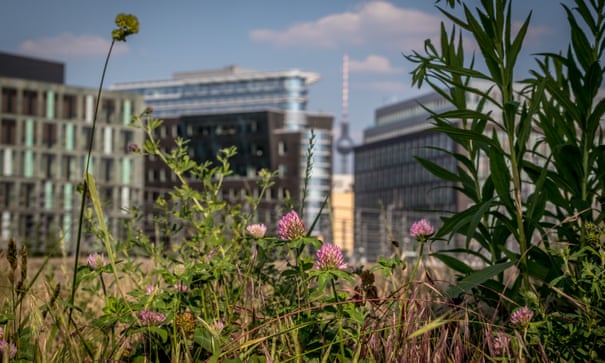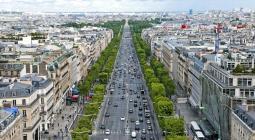10 great city projects for nature – from vertical forests to a ‘gangsta garden’
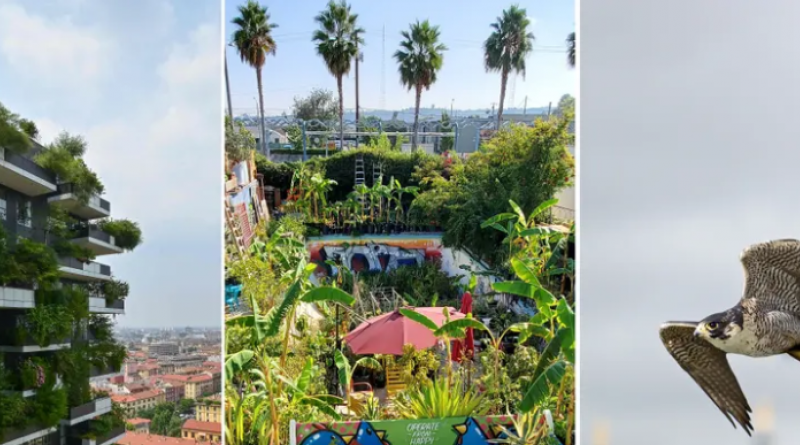
Around the world, architects, activists and communities are finding ways to bring wildlife into urban areas
Many readers have noticed wildflowers thriving in urban areas as city councils decide to let grass grow wild. These colourful little patches may seem like window dressing in the face of vast decline, but across the world people are welcoming wildlife into cities, where more than half of us live. Here is a look at 10 of the most exciting and innovative urban biodiversity projects popping up.
1. Vertical forests in Milan
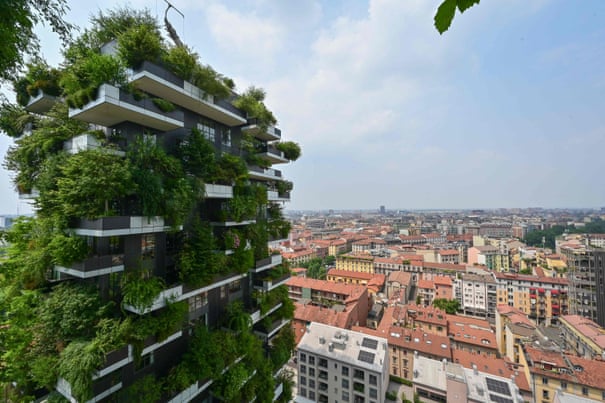
In Milan’s central business district, two plant-covered skyscrapers provide the same amount of vegetation as 30,000 sq metres of woodland, according to the architect, Stefano Boeri. The Bosco Verticale complex comprises two towers, 80 and 112 metres (260 and 367ft) tall, 800 trees, 15,000 ground-cover plants and 5,000 shrubs, which sit in big tubs on large overhanging balconies. Ecologists worked to make sure the plants were suitable for the location and they now attract 1,600 species of bird and butterfly, according to Boeri. The towers opened in 2014 and vegetation is trimmed so it doesn’t obstruct the view for residents. The architect has since created designs to build the world’s first Forest City in Liuzhou, China.
2. Wildlife bridges in Edmonton
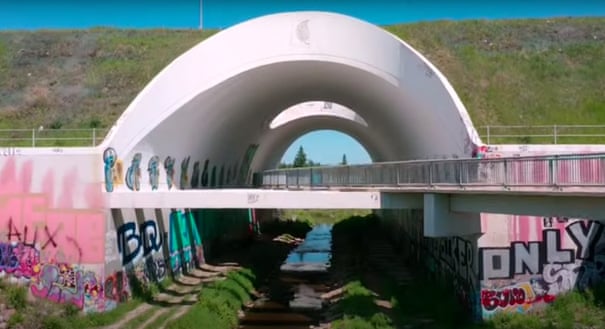
More than a dozen wildlife bridges and passages have been built in the Canadian city of Edmonton to maintain habitat connectivity and reduce human wildlife conflict. One of the largest is a 30-metre bridge near Big Lake in the north-west of the city, designed to be a corridor for moose and other ungulates. Trees on the bridge provide shelter for animals as they cross. Smaller bridges include special passes for salamanders and frogs so they can avoid the road as they move between the wetlands and forest. Similar passages have since been built all over world, including in Los Angeles, where the world’s largest wildlife bridge will extend over the 10-lane Highway 101 in a bid to protect mountain lion habitat.
3. Wuhan the ‘sponge city’
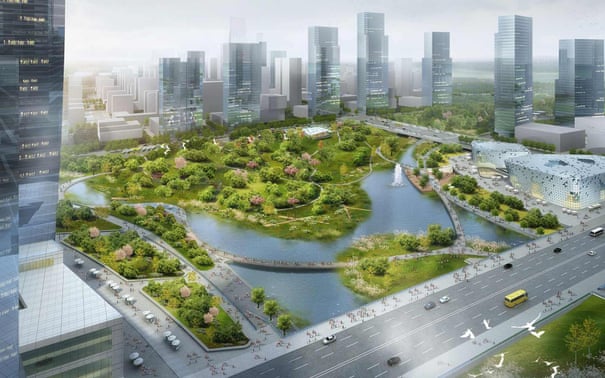
The now notorious city of Wuhan was declared China’s first “sponge city” based on its nature-based approach to flood defences. Permeable pavements, rain gardens, artificial ponds and wetlands were created throughout the city as ecologically friendly alternatives to traditional hard flood defences. The initiative, which has included 390 separate projects, started after more than a dozen people died because of flooding in Wuhan in 2016. It is believed to have cost $600m (£435m) less than upgrading the city’s drainage system. Wuhan was once known as “the city of a hundred lakes”, but most were paved over as the population grew. There are now more than 30 “sponge cities” in China.
4. Living with wild cats in Cape Town

Caracals – also known as desert lynx – are solitary, elusive creatures that are rarely seen but present in many nature reserves in Cape Town, as well as on estates and vineyards. They are the last remaining large predator on the Cape Peninsula. Being hit by a car is believed to be the greatest cause of mortality, causing as many as 70% of deaths. Researchers working on the Urban Caracal Project capture, mark and radio collar individuals to understand more about how the cats move through the urban landscape. Campaigners have been collaborating with a local artist to create artwork at road-kill hotspots to raise awareness. Caracal road signs have also gained a lot of attention around Cape Town, although it’s not known if this has helped reduce mortality.
5. Citizenship for bees in San José
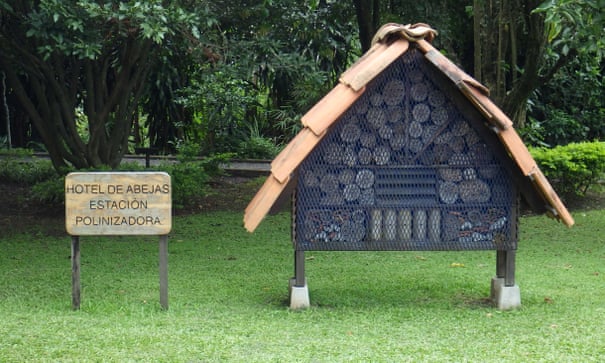
A suburb of Costa Rica’s capital, San José, has given citizenship to pollinators and native plants in an attempt to create a pioneering haven for wildlife. The neighbourhood of Curridabat is now known as “Ciudad Dulce” (Sweet City), where the widespread planting of native species ensures pollinators thrive. Green spaces are treated as infrastructure and incorporated into urban planning. In 2016, Sweet City became public policy, and since then authorities have focused on initiatives such as improving soil health, planting native species, managing water better, making it easier to walk around, and giving people access to healthy food.
6. Pocket farms in Sydney

In 2016, a lawn bowling club 5km from Sydney’s central business district was converted into an inner-city farm by Pocket City Farms group. The 1,200 sq metre market garden with its 16 sq metre compost unit in Camperdown is used to grow local organic food and educate people about healthy eating. The farm also has beehives and a greenhouse for seedlings. During lockdown, online orders increased from two a fortnight to more than 25 a week. Other community farms in Australia include Sydney City Farm, Green Connect urban farm in Wollongong, and Popes Produce, an urban farm in Illawarra.
7. Grey water in Dodoma
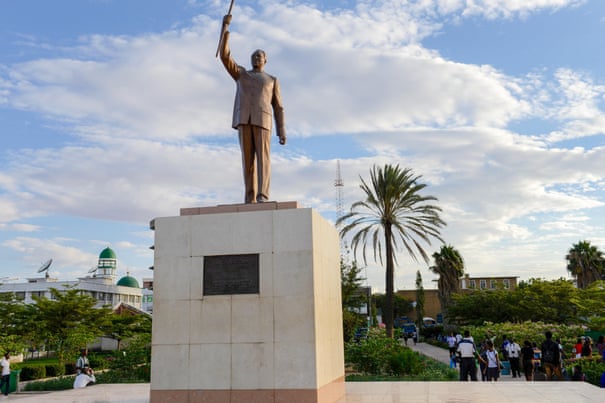
Grey water is relatively clean water that has been used in kitchen appliances such as washing machines and sinks but is not clean enough to drink. Recycling this water (which is often wasted) has transformed Nyerere Square in the centre of the drought-prone city of Dodoma, the capital of Tanzania. The square used to be a large concrete space, but has been transformed into an urban park filled with trees and plants to provide shelter for people and habitat for pollinators. But how do you keep it verdant in such a hot, arid region – by using grey water to irrigate the gardens.
8. Flower meadows in Berlin
Berlin is creating more than 50 wild gardens at a cost of €1.5m (£1.2m) as part of a bigger effort to save biodiversity in Germany. The country is home to 580 species of wild bee, 300 of which are found in Berlin, more than half of which are endangered or at risk of extinction. More than 100 wildflower meadows have been planted across Germany’s largest cities in the past three years, after a 2019 Bavarian “save the bees” petition, which got 1.75m signatures, making it the most successful in the southern German region’s history. The petition was created following research from 2017, which showed Germany had lost 75% of flying insect biomass since 1989.
9. Community gardens in Los Angeles
The Los Angeles Community Garden Council manages 42 community gardens and gives advice and workshops for 125 others, serving more than 6,000 families. The aim of the project is to link people from different backgrounds, create sustainable communities and encourage people to eat healthy, fresh food. In traditional gardens, people rent a plot to grow food for themselves; in educational gardens, the council teaches people about gardening and healthy eating; and in urban farms, volunteers grow vegetables to sell at market or give to people in need. A key leader in this movement is “gangsta gardener” Ron Finley from South Central Los Angeles who has travelled widely talking about his work, and features in a 2015 documentary about community gardens called Can You Dig This?. “If you ain’t a gardener, you ain’t gangsta,” he says.
10. Peregrine falcons in London
In 2003, the first peregrine falcon pair attempted to breed in London. Now, there are 30 pairs across the city. This is thanks to the availability of tall buildings where they can nest, an availability of food (pigeons and parakeets) and freedom from human persecution. The birds are protected by law, and maintenance work should be done from August to January outside of their breeding season. One of the first peregrine nesting sites in London was on Battersea power station. At a cost of more than £100,000, an alternative nest box was created for them on top of a purpose-built tower as part of the redevelopment. A new permanent nest house will be built when work finishes in 2022. The birds can also be seen on Tate Modern, the Houses of Parliament and Charing Cross hospital. Several of their nests have webcams in them. London is home to one of the densest populations of peregrine falcons in the world.
Find more age of extinction coverage here, and follow biodiversity reporters Phoebe Weston and Patrick Greenfield on Twitter for all the latest news and features
1 October 2021
